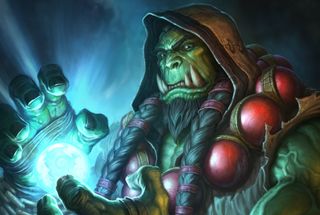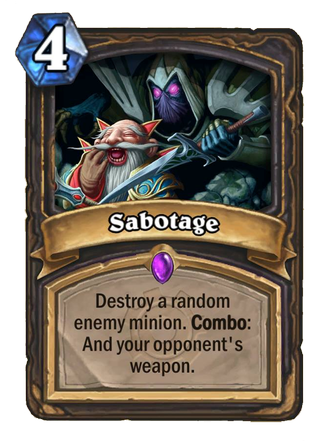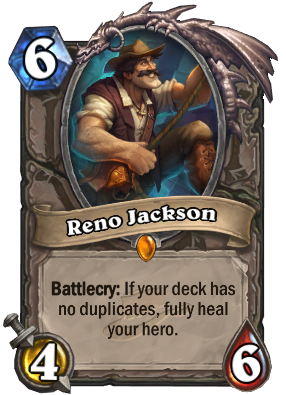Why does the Hearthstone meta get so stale, and how can Blizzard break the pattern?
A more active approach to balance is only part of the answer.

Here's a pattern that Hearthstone players are familiar with: an expansion is released, the game flourishes, then the meta begins to settle, and eventually it gets completely stale. The rhythm of card expansions means that the process might be inevitable for CCGs, but the amount of time it takes for boredom to set in can be manipulated. In order to work out how to change the pattern, it helps to understand the root cause.

Hands up who forgot this card exists.
The recent “Cart Crash at the Crossroads” Tavern Brawl, which both depressed and thrilled me, illustrates the problem perfectly. I’ve always loved Rogue, so I picked Valeera and played a bunch of games. And man, they felt so good. There was something about using Shadowstep on a minion for a powerful effect, or pulling off a surprise Sabotage, that made me feel like I was playing the vanilla version of Hearthstone again. It was like seeing all that beautiful and interesting Rogue design space for the first time.
Once that feeling had been reawakened, it quickly switched to frustration as I realized I would never be able to recreate the same experience in Standard or Wild as they currently exist. In fact, I had basically forgotten those cards existed before the Brawl.
“But can’t you go make a deck with those cards and have fun!” Were it so easy I would have done that a long time ago. There is a problem that keeps me from experimenting with that amazing design space: winning the game is part of the fun.
No one feels a passion for a game they cannot reliably win.
Effectively no one, no matter how little they claim to care about winning, feels a real passion for a game they cannot reliably win. As Herm Edwards once said:
“This is what’s great about sports; what the greatest thing about sports is: you play to win the game… you don’t play to just play it… And I don’t care if you don’t have any wins; you go play to win. When you start telling me, “It doesn’t matter,” then retire. Get out. Because it matters.”
The point here is that Hearthstone will only be fresh to the extent players feel they can experiment—exploring cool, interesting, original ideals—but be able to win while they do so. They don’t need to be able to win every game, but they do need to be able to win enough of them to feel like they’re accomplishing something. The more people are punished for playing lists other than the big meta decks, the staler the game will feel.
PC Gamer Newsletter
Sign up to get the best content of the week, and great gaming deals, as picked by the editors.
This puts an interesting spin on the discussion about what can be done to keep the game fresh. Some suggest that cards need to be released more often, and that can certainly help—but why? Well, because when new sets are released, lots of players will try out ideas because they like playing with new toys. At the beginning of any expansion, this works fine because everyone is experimenting too. The important result is that there are lots of unrefined decks running around. Because these unrefined decks have a lower power curve relative to the refined meta before the expansion, experimenting feels rewarding. You can play that new deck and still win with it.
In time, however, the meta will become so refined (ie the best decks and counters will have been “solved”) that it effectively seizes up. Precisely how fast it gets stale and how stale it becomes depends on a number of factors, chief among them the power difference between the best decks and everything else.
The power level of [Patches and Reno] decks is such that they crowd out other, more experimental decks.
To put that in terms of the current meta, decks with Patches the Pirate and Reno Jackson dominate basically all decks without them. The power level of these decks is such that they crowd out other, more experimental decks, either killing them by turn five or six with staggering regularity, or burying them under such preposterous mountains of value that there’s no coming back.
Sure, in one sense this Pirate and Reno meta is novel. There have arguably never been more viable control decks, it’s just that they all have to run Reno. And although these specific lists haven’t dominated the meta before, the archetypes being played are so similar that the experience still feels stale—and a lot of that is because these decks punish experimental or weaker strategies very harshly.

"Ronald" has surely outstayed his welcome now.
This point needs to be taken into account more vigilantly and earlier in the development process. In a recent interview, Hearthstone principal game designer Mike Donais said:
“I was thinking, I really enjoy Reno decks. A lot of our players on Ladder really enjoy Reno decks. They want it to be tier one, but right now, it's not tier one. Let's boost it up a little bit to tier one or tier two so that instead of just playing it for fun, they can play it and do reasonably well.”
Not to put too fine of a point on it, but this will have negative impacts for a few reasons. One of them is that the higher the power level of these cards, relative to other strategies, the worse the meta will stagnate. People like playing Reno decks and being able to win, but no one wants to play in a world where they are forced to play Reno decks if they want a halfway decent shot at winning. It seems Kazakus got the first part of that problem right, but the second part wrong.
When cards like Tunnel Trogg, Patches, Kazakus, and Drakonid Operative are created—cards that are so far above the average power curve—in order to boost specific classes or decks, you are risking stagnation of the meta for months or even years until they rotate out.
Because Patches and Small-Time Buccaneer exist, a large portion of the card pool has, in effect, been removed from the game.
This brings us, finally, to the question of whether nerfing overpowered cards would help. I think yes. Because players want to win, they are going to naturally gravitate towards the best cards. The stronger those options are, the more experimentation is punished, and the fewer cards effectively exist. You can even make the case that, because Patches and Small-Time Buccaneer exist, a large portion of the card pool has, in effect, been removed from the game. In this way, new card releases can actually reduce the pool of viable cards. As such, by nerfing the most oppressive cards, you are effectively creating new content.
That said, nerfing comes with risks, as the developers are well aware. If I like Azure Drake and it gets nerfed to the point of being unplayable, I will be upset and head to Reddit to let everyone know about it (RIP Blade Flurry). There are other options than nuking cards from orbit, though. One floated recently is moving cards to Wild instead of changing them. I think that could be a fantastic idea, as nerfs generally render cards unplayable anyway, barring rare exceptions. Better to have the card alive in Wild than dead in both Wild and Standard.

That's a nice meta you've got there. (Credit: Jamie Marciano)
However, to make those moves into Wild meaningful, Blizzard would need to take an additional step: make playing Wild as rewarding as Standard. While there’s a lot to say on the matter, the short version is that if there are no pragmatic reasons for competitive players to touch Wild, they mostly don’t. If all the competitive players stick to Standard, then playing Wild will feel worse for the less-competitive players too, since they often look to the competitive players for ideas and inspiration. By not incentivizing Wild, it leaves players feeling like they’re playing a different, somehow lesser, game of Hearthstone, much like how Softball and Baseball draw very different fandoms, despite surface-level similarities.
The second benefit to encouraging Wild is it would create two different metas that both require solving, thus providing more opportunities for innovation. If players are trying to solve two different metas, the game will stagnate more slowly than if they were just trying to solve one. There’s a lot more to be discussed when it comes to the details, but it all needs to begin with Blizzard taking a more proactive approach to balance, both before and after new cards are released. Otherwise there’s no reason to expect the pattern of stagnation to change anytime soon.
Most Popular





